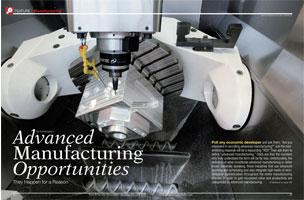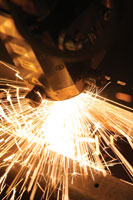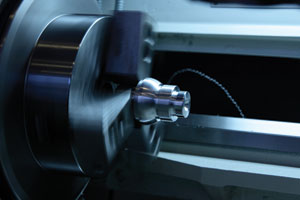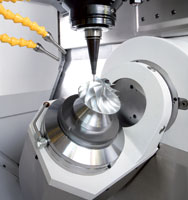
Poll any economic developer and ask them, “Are you interested in recruiting advanced manufacturing?” and the overwhelming response will be a resounding “YES!” Then ask them to define “advanced manufacturing.” Odds are that the numbers who truly understand the term will be far less. Unfortunately, the definition of what constitutes advanced manufacturing is rather broad. Generally speaking, those industries that use advanced planning and scheduling and also integrate high levels of technological sophistication throughout the entire manufacturing process in order to gain increased value and productivity are categorized as advanced manufacturing. Advanced manufacturing is not a description of a specific type of manufacturing; instead, it is both a philosophy and concept of continuous process improvement and adaptation that has a direct bearing on the suitability of a facility for any given community.
 Companies engaged in advanced manufacturing practices want to exist in an environment where innovation thrives, technological advances are accepted, and supply chain efficiencies meet to create market competitiveness. While the majority of these activities are the adoption of strict management practices and culture within the confines of an organization, there is also significant influence from outside the company walls that is a function of geography and place. For executives contemplating establishing a new operation, or those deliberating continued operations at an existing location, a review of the competitive landscape that supports advanced manufacturing would be prudent. Important factors to understand include: business assistance and incentives, workforce development, existing industries and potential suppliers, labor-management relations, support services, basic infrastructure, and innovation centers.
Companies engaged in advanced manufacturing practices want to exist in an environment where innovation thrives, technological advances are accepted, and supply chain efficiencies meet to create market competitiveness. While the majority of these activities are the adoption of strict management practices and culture within the confines of an organization, there is also significant influence from outside the company walls that is a function of geography and place. For executives contemplating establishing a new operation, or those deliberating continued operations at an existing location, a review of the competitive landscape that supports advanced manufacturing would be prudent. Important factors to understand include: business assistance and incentives, workforce development, existing industries and potential suppliers, labor-management relations, support services, basic infrastructure, and innovation centers.
When evaluating locations, there is value in understanding the business climate and level of support for investment in advanced manufacturing. The entire advanced manufacturing process is based on adding value for the consumer in the most efficient manner possible. Starting at the beginning, where lean manufacturing concepts and quality driven execution governs both rate of production and levels of finished product inventory, the advanced manufacturing process is competitive. Non-essential functions and waste are driven out to create value. Applying and adopting new technologies is not cheap; and, as a consequence, has inherent risks. A key business climate factor for an advanced manufacturing company to consider is the existence, or lack of, investment tax credits, abatements or refunds against tax liabilities at both the state and local levels. Tax policy defines the value that is placed on advanced manufacturing industries. There is no clearer message than a lack of incentives that focus only on job creation and ignores the catalyst that is responsible for it in the first place.
 Another critical aspect of success in advanced manufacturing is workforce development. Quality education for K-12 which continues on with top-notch college and university programs should be in tune with the needs of industry in the region to provide multiple educational opportunities. Notwithstanding the need for basic proficiency in reading, writing, math and communications in K-12, providing alternative educational paths to students is important. Parallel education paths for those wishing to pursue a technical path earlier, rather than later, is a fundamental recognition that education is a means to employment for most students and a source of qualified workers for business and industry. In some instances, and for some industries, certifications and expertise in certain fields (i.e., mechatronics) is just as important as bachelors and masters degrees. The workplace is becoming more and more complex and so are the skills and knowledge required to succeed and be effective. A lack of programs that provide alternate education paths not only sends a message to the students in the region about the value and importance of working in a manufacturing environment, it also speaks volumes to existing or would-be manufacturers. Similarly, colleges and universities should also try to establish collaboration and innovation with industry to not only provide qualified experts, but they should also strive to be a resource for problem solving and research. Advanced manufacturing technique is an automated production system of people, machines and tools for the planning and control of the production process, including the procurement of raw materials, parts, components, and the shipment and service of finished product. [i] Success in advanced manufacturing requires proficiency in, and collaboration among, engineering, business, logistics, marketing, and a host of other disciplines that are housed in most colleges and universities.
Another critical aspect of success in advanced manufacturing is workforce development. Quality education for K-12 which continues on with top-notch college and university programs should be in tune with the needs of industry in the region to provide multiple educational opportunities. Notwithstanding the need for basic proficiency in reading, writing, math and communications in K-12, providing alternative educational paths to students is important. Parallel education paths for those wishing to pursue a technical path earlier, rather than later, is a fundamental recognition that education is a means to employment for most students and a source of qualified workers for business and industry. In some instances, and for some industries, certifications and expertise in certain fields (i.e., mechatronics) is just as important as bachelors and masters degrees. The workplace is becoming more and more complex and so are the skills and knowledge required to succeed and be effective. A lack of programs that provide alternate education paths not only sends a message to the students in the region about the value and importance of working in a manufacturing environment, it also speaks volumes to existing or would-be manufacturers. Similarly, colleges and universities should also try to establish collaboration and innovation with industry to not only provide qualified experts, but they should also strive to be a resource for problem solving and research. Advanced manufacturing technique is an automated production system of people, machines and tools for the planning and control of the production process, including the procurement of raw materials, parts, components, and the shipment and service of finished product. [i] Success in advanced manufacturing requires proficiency in, and collaboration among, engineering, business, logistics, marketing, and a host of other disciplines that are housed in most colleges and universities.
An examination of the types of industries that are present in a region is another indication of the presence or absence of advanced manufacturing activities and the ease or difficulty of operations. A company with a vision of lean manufacturing operations will be hard pressed to succeed in an area that lacks service and maintenance support for critical manufacturing components, cost-effective and efficient logistics providers, or simply adequate information technology and internet services. An examination of the supply chain that exists to support the business enterprise is an obvious requirement that must be satisfied. For major OEMs, proximity of certain suppliers on a just-in-time basis is crucial. Key suppliers must be either located within the required distance, or they have to be able to establish an operation close enough to meet just-in-time procurement parameters. The presence of existing companies with several acres full of inventory could mean more than simply poor planning on the part of management and should bear some type of investigation.
An examination of the unions in a region – not so much on whether the companies are organized or not, but more on the circumstances surrounding the organization and the nature of the union in question – is another important evaluation of potential locations. If there are facilities in the community where there has been a contentious relationship between management and labor, this is an immediate red flag – especially if the work rules are particularly inflexible. Advanced manufacturing is dependent on being highly flexible and agile, capable of adapting not only to aberrations in day-to-day operations, but also making rapid changed due to market shifts as needed. Lean operations are very light at the top, with authority delegated as far down as possible and cross-functional skills and responsibilities promoted as much as possible. Finding people willing and able to perform in this environment is crucial to success.
 The information and support often found in a manufacturer’s association is also a valuable resource – although this varies considerably from location to location. The most helpful organization would be one that provides access to a database of qualified suppliers in the region, although the candid opinions of individuals cannot be discounted either. The database should identify products, services, capabilities and adherence to industry quality standards. In some locations this service is provided through multiple organizations such as the manufacturers association, economic development organizations, cluster groups or professional organizations. Most likely, no single organization will contain all the data, contacts and professional qualifications in one location. The important take-away, however, is that locations well suited for advanced manufacturing often have resources available (and if not located in a central location then the collaboration and inter-workings of the various organizations are established).
The information and support often found in a manufacturer’s association is also a valuable resource – although this varies considerably from location to location. The most helpful organization would be one that provides access to a database of qualified suppliers in the region, although the candid opinions of individuals cannot be discounted either. The database should identify products, services, capabilities and adherence to industry quality standards. In some locations this service is provided through multiple organizations such as the manufacturers association, economic development organizations, cluster groups or professional organizations. Most likely, no single organization will contain all the data, contacts and professional qualifications in one location. The important take-away, however, is that locations well suited for advanced manufacturing often have resources available (and if not located in a central location then the collaboration and inter-workings of the various organizations are established).
Infrastructure condition and adequacy, both now and in the future, are important and often overlooked. Reliable power and the willingness of local utility providers to ensure quality service may seem like a given in most regions, until a transformer blows due to downed power lines with no back-up power source. Spending time trying to fuel a back-up generator and hoping you have enough power until service is restored is not the best use of a plant manager’s time. Often, high-speed internet service presence and reliability is overlooked – until road construction cuts a trunk line and inventory supply orders have to be done by cell phone. And there are still places in the United States that do not have broadband internet service. Last but not least is the importance of the transportation network. While major transportation corridors for incoming just-in-time supplies and outgoing finished goods are scrutinized heavily, secondary routes for employee commutes are almost always assumed to be adequate. The location of the facility in relationship to employee commute patterns may not seem important until half a shift is several hours late due to a washed out bridge or inclement weather.
A sometimes difficult to measure factor, much less explain, is the concept of centers of innovation. Advanced manufacturing environments are many times the result, and creation, of the companies themselves through policies and culture that adhere to and promote innovation and creativity. Although the policies and culture are within the organization, it is equally important they exist in the region as well. In some instances there may be a cluster of industries with similar operations and techniques that foster this environment, such as companies that are highly technical or have extensive research and development capabilities. In other locations, innovation may stem from the presence of a college or a university – provided that the educational institution is outward-focused and collaborative as opposed to being inward-focused and shut off. Even two-year technical schools that work extensively with industry in a problem solving mode is meaningful. Forward-thinking local and regional government agencies that understand the need to govern effectively and will take unique approaches to promote and/or preserve economic development and prosperity for the region are yet another example. In the best of all worlds, these organizations are all present, work together, and are in perfect harmony. The reality is that they are usually willing, but need proactive guidance and beseeching to come to a meeting of the minds.
 The realities of the economic environment have fueled the steady migration of the United States industry towards advanced manufacturing practices over the last two decades. The natural evolution of free market systems virtually assures that certain supplies and components will be produced in the lowest cost location – which means some off-shoring is inevitable to remain cost-competitive possible. In contrast, the low-cost location is also the place where utilization of advanced manufacturing technology is embraced and supported through policies and actions that support and value it. Some would characterize the loss of manufacturing jobs in the United States to a failure of policies at the local, state and even the federal level to create an environment where increased competition is based on technology, innovation and efficiency – not simply low wages and incentives that focus only on non-value-added operating cost efficiencies. This is a difficult argument to counter in general from a macro-perspective. Still, there are regions and communities that are prospering and growing and have weathered the economic recession fairly well. This is no accident.
The realities of the economic environment have fueled the steady migration of the United States industry towards advanced manufacturing practices over the last two decades. The natural evolution of free market systems virtually assures that certain supplies and components will be produced in the lowest cost location – which means some off-shoring is inevitable to remain cost-competitive possible. In contrast, the low-cost location is also the place where utilization of advanced manufacturing technology is embraced and supported through policies and actions that support and value it. Some would characterize the loss of manufacturing jobs in the United States to a failure of policies at the local, state and even the federal level to create an environment where increased competition is based on technology, innovation and efficiency – not simply low wages and incentives that focus only on non-value-added operating cost efficiencies. This is a difficult argument to counter in general from a macro-perspective. Still, there are regions and communities that are prospering and growing and have weathered the economic recession fairly well. This is no accident.
[i] Effective Factors on Advanced Manufacturing Technology Implementation Performance: http://scialert.net/fulltext/?doi=jas.2010.1229.1242&org=11

